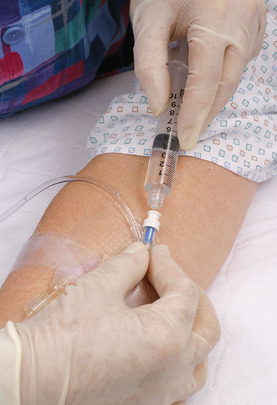1. Identify the types of parenteral medications and nutrition, and name at least three situations where it would be beneficial to use a parenteral dose form. 2. Describe two types of intravenous (IV) administration, and give an example of each. 3. Name two advantages and two disadvantages of administering IV medications. 4. Discuss the types of parenteral medications and supplies used in both health-system IV administration and home infusion therapy, and explain the technician’s integral role in preventing medication errors when considering administration of parenteral medications. Injection into the epidural space Injection into the cardiac muscle or the heart Injection into the dermal layer of the skin Injection into the spinal canal Also known as bolus; small amount of medication injected into a port usually in an existing IV line Lactated Ringer’s solution (LR) Sterile isotonic intravenous fluid used for electrolyte or fluid replacement Subcutaneous route of administration (Sub-Q) Injection just below the skin into the subcutaneous fat layer Epidural injections are given into the epidural space, such as anesthesia medication during labor. • Experiencing extreme nausea and vomiting • Unable to swallow a tablet, such as a child or elderly patient • Uncooperative due to illness, such as psychiatric disorders • Experiencing a life-threatening situation, such as blood loss, where immediate replacement intervention is required • Unable to absorb medication through the gastrointestinal (GI) tract due to disease IV medications may be given continuously or intermittently. This is usually in the form of a large volume parenteral (LVP) between 250 to 1000 mL and over 2 to 24 hours. The orders will determine a rate of infusion, which is the amount of fluid that should enter the body over a certain period of time (Figure 2-1). This is often regulated with an infusion pump or electronic device. Examples of IV injections include hydration fluids, blood products, or drugs that need to be maintained at a constant or steady level for the patient.
Administration of intravenous products
Introduction
Parenteral medications and nutrition
Intravenous administration
![]()
Stay updated, free articles. Join our Telegram channel

Full access? Get Clinical Tree


Administration of intravenous products

